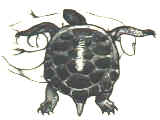|
What do we have to look for when
buying or getting a healty turtle.
-
Make sure it's eyes aren't swollen but are clear, open
and have a bright glanse on them. Swollen eyes are often the result of
poor water quality or a vitamin A deficiency.
-
when you try to get a hold of the turtle, does it try
to swim away or does it stay put? healthy animals instinctevely try to
get away.
-
Is the turtle shell intact? Does it feel hard? If the
animals shell feels soft then this animal has a calcium deficiency.
-
When the animal walks on land, does it use all of its
legs?
-
When the animals breaths it's mouth must be closed.
They should breath through there nose and not make any sound.
Animals that make a "whistling" sound may a have
respiratory disease.
-
Ask the person you are getting the animal from,
if it's eating normaly. Let him give the turtle a peace of food, and
see if its eaten immidiatly.
-
Does the tank where the animals house in look
clean?
-
Put the animals on its back, A healthy animal will try
to get on its legs again
 |
If you pick up the turle with its front legs, is it
strong enough to hold on and pull its self up? |
|
Some people have to learn the hard way
and have there own opinion on how to keep turtles. That's fine by me, but
think about the animals first and then about yourself. Aquarium that is
decorated with plants ect...is nicer to look at than a tank with nothing
in it, i agree, but do turtles need decoration? Plastic plants won't do, because
they will eat them and this may cause harm to the animal. There are many
things people put in there tank together with there turtles, just to have
it look nicer. It's just like some fiche tanks with the sunken boats and the
plastic treasure trunk that blows air bubbles... terrible, but tastes
differ.
Putting a water heater in the tank is a wrong way of keeping turtles.
These heaters are dangerous and should not be fitted in a turtle tank.
They could cause electric shock to you and your animals. When you want to
use a heater for what ever reason, unplug the electrical cord before going
into the tank with your hands. Make sure the heater is secured behind a
peace of glass or put it in your filter when this is possible. Heating the water is fine but you have to heat the air
too. This is the
mistake that is made to often, the air temp. is colder than the water
temp. If you heat the water temp. to about 24 °C and the air temp. is
only 18-22° C(roomtemp.) then the animals will constantly breath cold air
and this way turtles may get respiratory infections. Vie seen people that
use light bulbs and keep them burning day and night. The animals need to
have a resting period and nighttime is the Wright time. Instead of a clear
light bulb of 60 Watt, put in a dark colored one of 25 watt ( red, green,
bleu). This giver's a little light and a little heat. The temp. has to go
down at night just like it does in nature, thus giving the animals a
natural sleeping period.
Give your animals a wide veraity of food, don't give adult animals food
everyday, 2 times a week is more than enough. If you do want to feed them
everyday give small portions. If you feed and there's some food left in
the water then you fed them to much. Juveniles can be fed daily. Animals
that are fed daily get fat, this could lead to there dead.
Don't buy or take in to much turtles at once. Juveniles are small, but
some species grow very fast and get very big, so that the tank you bought
for your baby turtles will soon be to small. Try to stay with one species,
don't start a collection of animals from different regions which all need
different kind of housing and or food. Don't buy a tank and a turtle at
the same time. Get the tank installed and get it running with light and
filters, then if everything works get the animals you want. If you already
got a few turtles and you want to expand your collection, put the new
animals in quarantine for a couple of weeks.
|